旅游酒店英语教案
- 格式:doc
- 大小:100.00 KB
- 文档页数:14
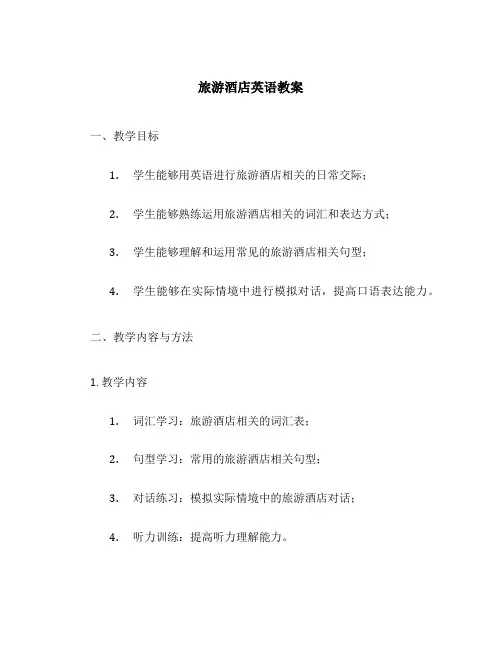
旅游酒店英语教案一、教学目标1.学生能够用英语进行旅游酒店相关的日常交际;2.学生能够熟练运用旅游酒店相关的词汇和表达方式;3.学生能够理解和运用常见的旅游酒店相关句型;4.学生能够在实际情境中进行模拟对话,提高口语表达能力。
二、教学内容与方法1. 教学内容1.词汇学习:旅游酒店相关的词汇表;2.句型学习:常用的旅游酒店相关句型;3.对话练习:模拟实际情境中的旅游酒店对话;4.听力训练:提高听力理解能力。
2. 教学方法1.情境导入法:通过图片、视频等方式引入旅游酒店相关主题;2.课堂讲解法:通过课堂讲解介绍相关词汇、句型等知识点;3.对话练习法:将学生分为小组进行对话练习,操练旅游酒店相关的对话;4.听力训练法:通过播放录音材料进行听力训练,提高听力理解能力;5.角色扮演法:安排学生在旅游酒店情境中进行角色扮演,提高口语表达能力。
三、教学步骤1. 词汇学习教师通过图片和声音示范方式向学生介绍和教授以下词汇:•hotel - 酒店•reservation - 预订•check-in - 入住•check-out - 退房•room service - 客房服务•bellboy - 侍者•front desk - 前台•keycard - 门卡•elevator - 电梯•concierge - 门房2. 句型学习教师通过课堂讲解和示范向学生介绍和教授以下句型:•Can I make a reservation? - 我可以预订吗?•I would like to check in. - 我想要办理入住手续。
•Can I have a room with a view? - 我可以要一个可以看到风景的房间吗?•How much does it cost per night? - 每晚多少钱?•Where is the front desk? - 前台在哪里?•Can I have some extra towels? - 我可以要一些额外的毛巾吗?3. 对话练习教师组织学生分组进行对话练习,模拟旅游酒店情境。
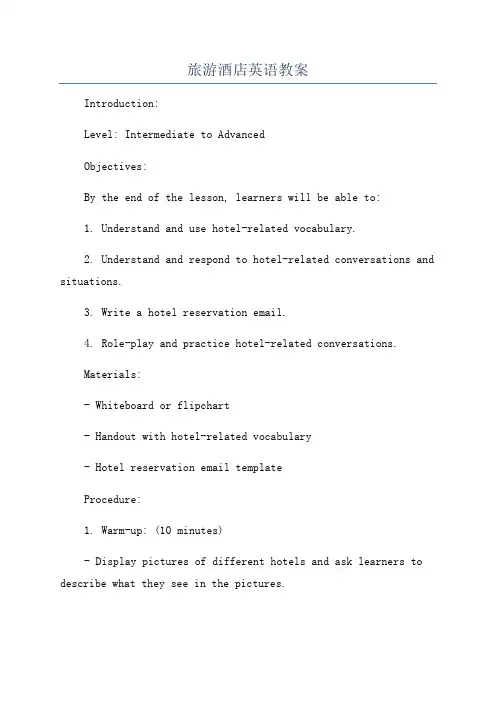
旅游酒店英语教案Introduction:Level: Intermediate to AdvancedObjectives:By the end of the lesson, learners will be able to:1. Understand and use hotel-related vocabulary.2. Understand and respond to hotel-related conversations and situations.3. Write a hotel reservation email.4. Role-play and practice hotel-related conversations.Materials:- Whiteboard or flipchart- Handout with hotel-related vocabulary- Hotel reservation email templateProcedure:1. Warm-up: (10 minutes)- Display pictures of different hotels and ask learners to describe what they see in the pictures.- Introduce the topic of hotels and elicit any prior knowledge or experiences learners may have had in staying at hotels.2. Vocabulary Activity: (15 minutes)- Handout the hotel-related vocabulary sheet.- Ask learners to work in pairs to match the vocabulary words with their definitions.- Conduct a brief class feedback session to check answers.3. Listening Activity: (20 minutes)- Play an audio recording of a hotel check-in conversation.4. Speaking Activity: (20 minutes)- Divide the class into pairs and provide them with a role-play scenario.- Scenario: One learner is a hotel receptionist, and the other is a guest who wants to make a reservation.- Learners should take turns playing both roles.- Provide learners with a list of questions and phrases that they can refer to during the role-play.- Monitor the pairs and provide feedback on their language use and pronunciation.5. Reading and Writing Activity: (25 minutes)- Display a hotel reservation email template on the board or distribute copies to learners.- Instruct learners to read the template and underline any key phrases or information.- Explain the purpose and structure of a hotel reservation email.- Ask learners to write their own hotel reservation email, using the provided template as a guide.- Encourage learners to be creative with their imaginary hotel stay.- Provide support and assistance to learners as needed.6. Role-play Activity: (20 minutes)- Instruct learners to create a short role-play based on their scenario.- Help groups prepare their role-plays by brainstorming ideas and providing language support.- Have each group perform their role-play in front of the class.- Encourage other learners to ask questions or engage in the role-play to make it more interactive.7. Follow-up Activity: (10 minutes)- Conduct a class discussion on the importance of good customer service in the hotel industry.- Ask learners to share their thoughts and experiences on both positive and negative encounters with hotel staff.- Discuss the impact of good customer service on customer satisfaction and loyalty.Conclusion:。
![旅游专业英语(第四版)第四章教案 (3)[4页]](https://uimg.taocdn.com/dbcf68ed8ad63186bceb19e8b8f67c1cfad6ee62.webp)
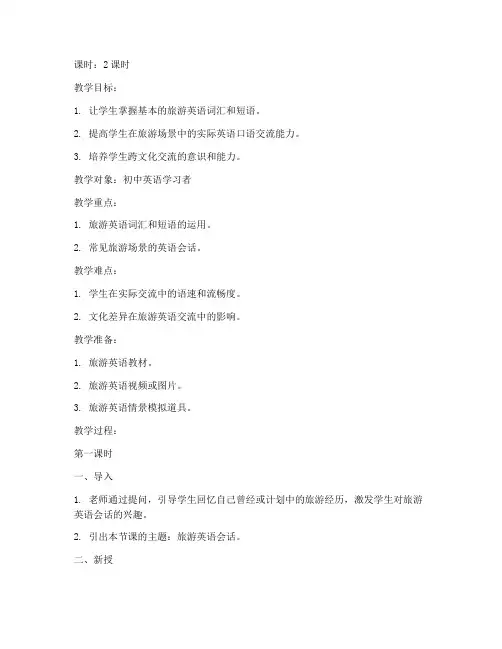
课时:2课时教学目标:1. 让学生掌握基本的旅游英语词汇和短语。
2. 提高学生在旅游场景中的实际英语口语交流能力。
3. 培养学生跨文化交流的意识和能力。
教学对象:初中英语学习者教学重点:1. 旅游英语词汇和短语的运用。
2. 常见旅游场景的英语会话。
教学难点:1. 学生在实际交流中的语速和流畅度。
2. 文化差异在旅游英语交流中的影响。
教学准备:1. 旅游英语教材。
2. 旅游英语视频或图片。
3. 旅游英语情景模拟道具。
教学过程:第一课时一、导入1. 老师通过提问,引导学生回忆自己曾经或计划中的旅游经历,激发学生对旅游英语会话的兴趣。
2. 引出本节课的主题:旅游英语会话。
二、新授1. 教师讲解旅游英语词汇和短语,如:hotel(酒店)、airport(机场)、tourist attraction(旅游景点)、excursion(短途旅行)等。
2. 通过例句,让学生学会运用这些词汇和短语进行简单的旅游英语对话。
三、情景模拟1. 老师创设旅游场景,如:在机场、酒店、旅游景点等,让学生进行角色扮演。
2. 学生在模拟过程中,运用所学词汇和短语进行对话。
四、课堂练习1. 学生分组进行角色扮演,模拟旅游过程中的各种场景。
2. 教师巡回指导,纠正学生的发音和语法错误。
五、总结1. 老师对本节课所学内容进行总结,强调重点词汇和短语。
2. 学生分享自己在模拟过程中的感受和收获。
第二课时一、复习1. 老师带领学生复习上节课所学内容,巩固旅游英语词汇和短语。
2. 学生进行小组讨论,分享自己在旅游过程中的英语交流经历。
二、拓展1. 教师展示一些旅游英语视频或图片,让学生了解不同国家的旅游文化。
2. 学生分组讨论,总结不同国家的旅游礼仪和习惯。
三、情景模拟1. 老师创设一个具有挑战性的旅游场景,如:在异国他乡求助、解决旅行中的问题等。
2. 学生分组进行角色扮演,运用所学知识解决问题。
四、课堂练习1. 学生分组进行旅游英语对话,模拟真实的旅游场景。
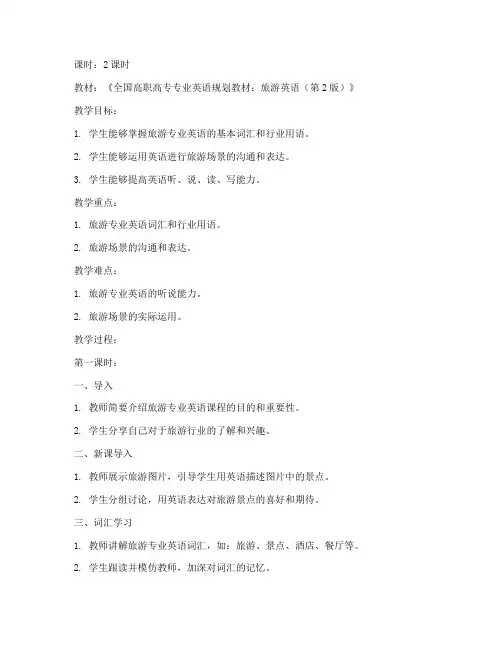
课时:2课时教材:《全国高职高专专业英语规划教材:旅游英语(第2版)》教学目标:1. 学生能够掌握旅游专业英语的基本词汇和行业用语。
2. 学生能够运用英语进行旅游场景的沟通和表达。
3. 学生能够提高英语听、说、读、写能力。
教学重点:1. 旅游专业英语词汇和行业用语。
2. 旅游场景的沟通和表达。
教学难点:1. 旅游专业英语的听说能力。
2. 旅游场景的实际运用。
教学过程:第一课时:一、导入1. 教师简要介绍旅游专业英语课程的目的和重要性。
2. 学生分享自己对于旅游行业的了解和兴趣。
二、新课导入1. 教师展示旅游图片,引导学生用英语描述图片中的景点。
2. 学生分组讨论,用英语表达对旅游景点的喜好和期待。
三、词汇学习1. 教师讲解旅游专业英语词汇,如:旅游、景点、酒店、餐厅等。
2. 学生跟读并模仿教师,加深对词汇的记忆。
四、情景对话1. 教师设计旅游场景,如:预订酒店、询问路线等。
2. 学生分组进行角色扮演,用英语进行对话。
五、课堂小结1. 教师总结本节课所学内容,强调重点词汇和行业用语。
2. 学生分享自己在课堂上的收获和感悟。
第二课时:一、复习导入1. 教师提问学生上一节课所学内容,检查学生对词汇和行业用语的掌握程度。
2. 学生分享自己在旅游过程中的英语沟通经历。
二、阅读理解1. 教师发放旅游专业英语阅读材料,如:旅游指南、景点介绍等。
2. 学生阅读材料,并回答相关问题。
三、听力训练1. 教师播放旅游专业英语听力材料,如:旅游咨询、景点介绍等。
2. 学生听完后,回答相关问题。
四、口语表达1. 教师设计旅游场景,如:询问景点门票、推荐餐厅等。
2. 学生分组进行角色扮演,用英语进行对话。
五、课堂小结1. 教师总结本节课所学内容,强调学生的口语表达和听力理解能力。
2. 学生分享自己在课堂上的收获和感悟。
教学评价:1. 学生对旅游专业英语词汇和行业用语的掌握程度。
2. 学生在旅游场景中的英语沟通能力。
3. 学生在阅读和听力训练中的表现。
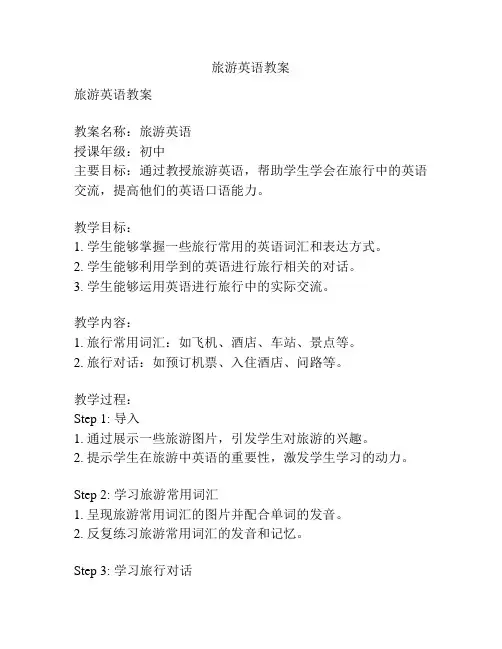
旅游英语教案旅游英语教案教案名称:旅游英语授课年级:初中主要目标:通过教授旅游英语,帮助学生学会在旅行中的英语交流,提高他们的英语口语能力。
教学目标:1. 学生能够掌握一些旅行常用的英语词汇和表达方式。
2. 学生能够利用学到的英语进行旅行相关的对话。
3. 学生能够运用英语进行旅行中的实际交流。
教学内容:1. 旅行常用词汇:如飞机、酒店、车站、景点等。
2. 旅行对话:如预订机票、入住酒店、问路等。
教学过程:Step 1: 导入1. 通过展示一些旅游图片,引发学生对旅游的兴趣。
2. 提示学生在旅游中英语的重要性,激发学生学习的动力。
Step 2: 学习旅游常用词汇1. 呈现旅游常用词汇的图片并配合单词的发音。
2. 反复练习旅游常用词汇的发音和记忆。
Step 3: 学习旅行对话1. 呈现一些旅行对话的情景,如预订机票、入住酒店、问路等,并进行解释和示范。
2. 学生跟读并模仿对话,提高他们的口语表达能力。
Step 4: 练习1. 分组练习:将学生分成小组,让他们进行旅行对话的练习。
2. 角色扮演:学生分别扮演旅客和旅游工作人员,进行实际对话练习。
Step 5: 任务1. 给学生一个旅行任务,让他们利用学到的英语在实际情境中进行交流。
2. 学生完成任务后,进行班级讨论和反馈,提供指导和纠正。
Step 6: 总结和评价1. 总结学到的旅游英语表达方式和交流技巧。
2. 对学生的学习进行评价和反馈,鼓励他们继续学习和提高。
Step 7: 拓展1. 提供一些旅游英语学习资源,如英语教材、词汇卡片、听力练习等,让学生自主学习和巩固所学知识。
2. 鼓励学生参加一些英语角、英语活动,提高他们的英语口语和交流能力。
Step 8: 结束总结本节课的收获和体会,并鼓励学生在实际旅行中尽量运用学到的英语。
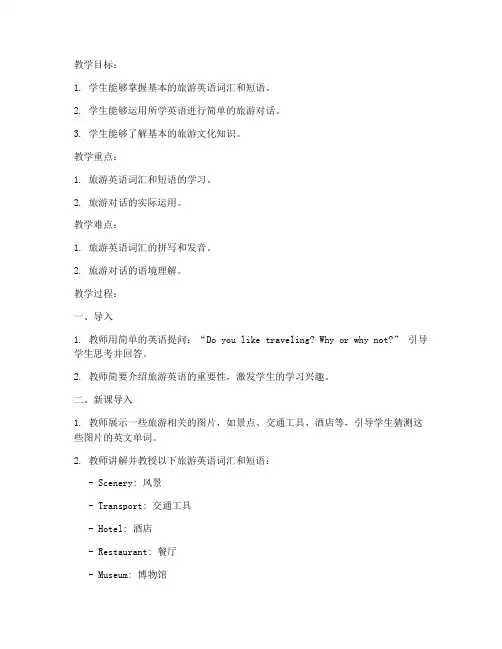
教学目标:1. 学生能够掌握基本的旅游英语词汇和短语。
2. 学生能够运用所学英语进行简单的旅游对话。
3. 学生能够了解基本的旅游文化知识。
教学重点:1. 旅游英语词汇和短语的学习。
2. 旅游对话的实际运用。
教学难点:1. 旅游英语词汇的拼写和发音。
2. 旅游对话的语境理解。
教学过程:一、导入1. 教师用简单的英语提问:“Do you like traveling? Why or why not?” 引导学生思考并回答。
2. 教师简要介绍旅游英语的重要性,激发学生的学习兴趣。
二、新课导入1. 教师展示一些旅游相关的图片,如景点、交通工具、酒店等,引导学生猜测这些图片的英文单词。
2. 教师讲解并教授以下旅游英语词汇和短语:- Scenery: 风景- Transport: 交通工具- Hotel: 酒店- Restaurant: 餐厅- Museum: 博物馆- Ticket: 票- Guidebook: 旅行指南- Souvenir: 纪念品三、课堂练习1. 教师带领学生进行以下练习:- 拼写练习:学生拼写刚刚学过的旅游英语词汇。
- 发音练习:学生跟读并模仿教师的发音。
- 造句练习:学生运用所学词汇和短语进行造句。
四、情景对话1. 教师创设以下情景,引导学生进行对话:- 在机场询问航班信息。
- 在酒店预订房间。
- 在餐厅点餐。
- 在景点询问路线。
2. 教师分组进行角色扮演,让学生在实际情景中运用所学英语。
五、总结与作业1. 教师总结本节课所学内容,强调重点和难点。
2. 布置以下作业:- 复习本节课所学词汇和短语。
- 预习下一节课的内容。
教学反思:本节课通过图片、词汇、情景对话等多种形式,让学生在轻松愉快的氛围中学习旅游英语。
在今后的教学中,我将继续关注学生的学习效果,适时调整教学方法,以提高学生的英语实际运用能力。
旅游英语教案范文:一、教学目标1. 学生能够掌握基本的旅游英语词汇和短语。
2. 学生能够运用所学英语进行简单的旅游对话。
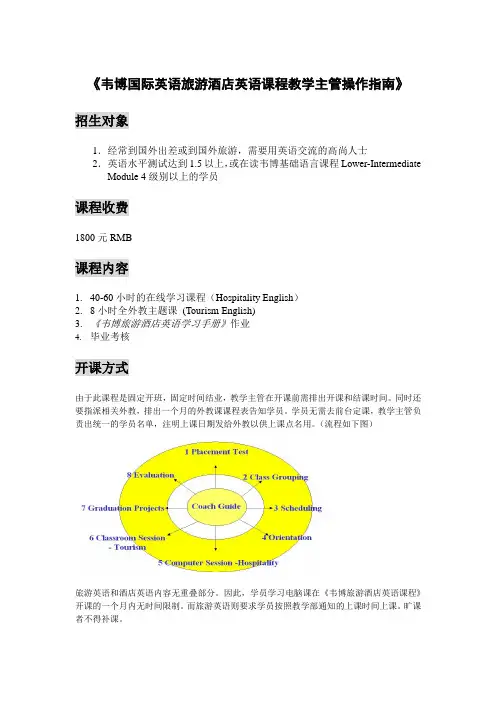
《韦博国际英语旅游酒店英语课程教学主管操作指南》招生对象1.经常到国外出差或到国外旅游,需要用英语交流的高尚人士2.英语水平测试达到1.5以上,或在读韦博基础语言课程Lower-Intermediate Module 4级别以上的学员课程收费1800元RMB课程内容1.40-60小时的在线学习课程(Hospitality English)2.8小时全外教主题课(Tourism English)3.《韦博旅游酒店英语学习手册》作业4.毕业考核开课方式由于此课程是固定开班,固定时间结业,教学主管在开课前需排出开课和结课时间。
同时还要指派相关外教,排出一个月的外教课课程表告知学员。
学员无需去前台定课,教学主管负责出统一的学员名单,注明上课日期发给外教以供上课点名用。
(流程如下图)旅游英语和酒店英语内容无重叠部分。
因此,学员学习电脑课在《韦博旅游酒店英语课程》开课的一个月内无时间限制。
而旅游英语则要求学员按照教学部通知的上课时间上课。
旷课者不得补课。
学生入学后,教学主管指派一名Tutor指导学员完成入学水平测试Placement Test), 入学指导(Orientation), 酒店英语电脑课(Computer Session –Hospitality), 旅游英语外教课(Classroom Session – Tourism), 毕业课题(Graduation Projects), 毕业测试(Evaluation)。
毕业要求学员在课程结束时,如满足以下要求即可毕业:1.英语基础水平达到PT 2.0以上(或Lower-Intermediate级别以上)2.完成在线学习课程(Hospitality English)3.完成4个主题8小时的外教课程(Tourism English)4.完成《韦博旅游酒店英语学习手册》)所有的阅读和写作作业5.完成旅游英语毕业课题一个。
课程概览1.在线学习酒店英语课程: 6单元, 40-60小时学习,难度1.5-3.0Unit 1 Reception (2.5-3.2, 对应韦博级别:BA-A)Unit 2 Restaurant (2.0-2.7, 对应韦博级别:BI-BA)Unit 3 Cashier & Check-Out (1.5-2, 对应韦博级别:I-BI)Unit 4 Guest Service (2-2.5, 对应韦博级别:BI-BA)Unit 5 Guest Relations and Sales (1.5-2, 对应韦博级别:I-BI)Unit 6 Telephone (1.7-2.2, 对应韦博级别:I-BI)2.主题旅游英语外教课(总部发放统一教案)Lesson One: Preparing for an overseas tripLesson Two: Airport & ArrivalLesson Three: Activities and AdventuresLesson Four: Dining Out*注:请将相关的课程标题,课程时间及上课地点的通知在Orientation时发给学员。
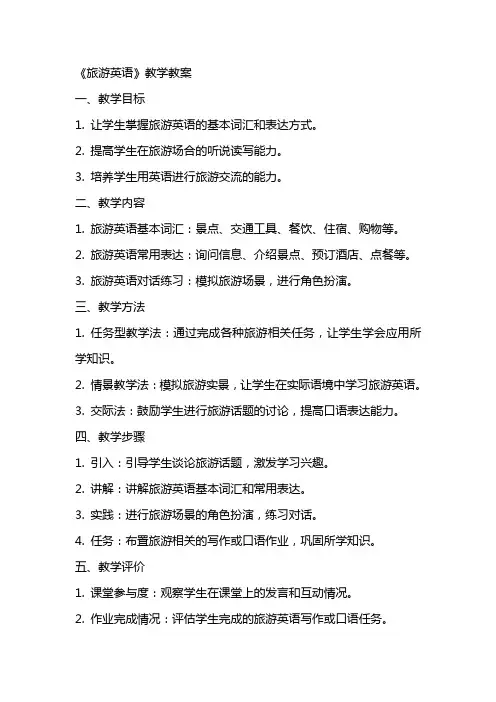
《旅游英语》教学教案一、教学目标1. 让学生掌握旅游英语的基本词汇和表达方式。
2. 提高学生在旅游场合的听说读写能力。
3. 培养学生用英语进行旅游交流的能力。
二、教学内容1. 旅游英语基本词汇:景点、交通工具、餐饮、住宿、购物等。
2. 旅游英语常用表达:询问信息、介绍景点、预订酒店、点餐等。
3. 旅游英语对话练习:模拟旅游场景,进行角色扮演。
三、教学方法1. 任务型教学法:通过完成各种旅游相关任务,让学生学会应用所学知识。
2. 情景教学法:模拟旅游实景,让学生在实际语境中学习旅游英语。
3. 交际法:鼓励学生进行旅游话题的讨论,提高口语表达能力。
四、教学步骤1. 引入:引导学生谈论旅游话题,激发学习兴趣。
2. 讲解:讲解旅游英语基本词汇和常用表达。
3. 实践:进行旅游场景的角色扮演,练习对话。
4. 任务:布置旅游相关的写作或口语作业,巩固所学知识。
五、教学评价1. 课堂参与度:观察学生在课堂上的发言和互动情况。
2. 作业完成情况:评估学生完成的旅游英语写作或口语任务。
3. 期末考试:测试学生旅游英语的综合运用能力。
六、教学资源1. 教材:《旅游英语》教材或相关旅游英语学习资料。
2. 多媒体课件:旅游景点图片、视频、音频等。
3. 角色扮演道具:地图、飞机票、酒店卡片等。
4. 在线资源:旅游英语学习网站、旅游资讯网站等。
七、教学环境1. 教室布局:座位排列便于学生互动交流。
2. 教学设备:投影仪、音响、计算机等。
3. 氛围营造:轻松愉快的旅游主题氛围,如播放旅游相关音乐。
八、教学策略1. 差异化教学:针对不同水平的学生,提供相应难度的旅游英语学习材料。
2. 激励机制:设置旅游主题的奖励,鼓励学生积极参与。
3. 合作学习:组织学生进行小组讨论,共同完成旅游英语任务。
九、教学计划1. 课时安排:每课时45分钟,共15课时。
2. 课程进度:按照教学大纲和教材安排课程内容。
3. 作业布置:每节课后布置相关旅游英语作业,巩固所学知识。
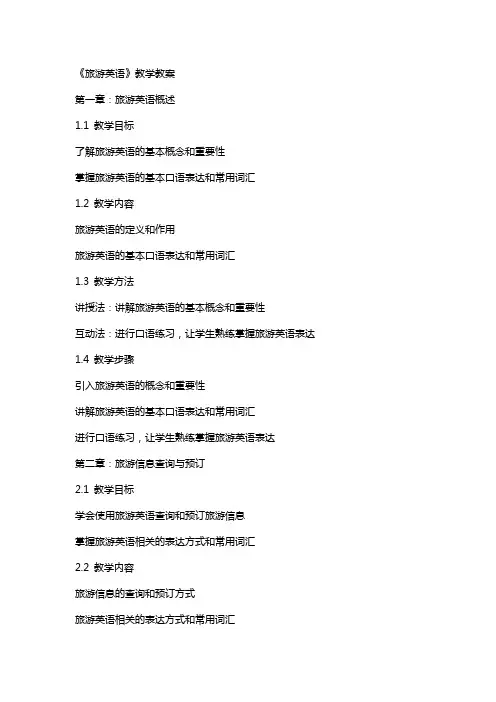
《旅游英语》教学教案第一章:旅游英语概述1.1 教学目标了解旅游英语的基本概念和重要性掌握旅游英语的基本口语表达和常用词汇1.2 教学内容旅游英语的定义和作用旅游英语的基本口语表达和常用词汇1.3 教学方法讲授法:讲解旅游英语的基本概念和重要性互动法:进行口语练习,让学生熟练掌握旅游英语表达1.4 教学步骤引入旅游英语的概念和重要性讲解旅游英语的基本口语表达和常用词汇进行口语练习,让学生熟练掌握旅游英语表达第二章:旅游信息查询与预订2.1 教学目标学会使用旅游英语查询和预订旅游信息掌握旅游英语相关的表达方式和常用词汇2.2 教学内容旅游信息的查询和预订方式旅游英语相关的表达方式和常用词汇讲授法:讲解旅游信息的查询和预订方式互动法:进行角色扮演,让学生熟练掌握旅游英语表达2.4 教学步骤引入旅游信息的查询和预订方式讲解旅游英语相关的表达方式和常用词汇进行角色扮演,让学生熟练掌握旅游英语表达第三章:机场与航空公司3.1 教学目标学会使用旅游英语与机场和航空公司人员进行沟通掌握机场和航空公司相关的表达方式和常用词汇3.2 教学内容机场和航空公司的基本流程和相关规定旅游英语相关的表达方式和常用词汇3.3 教学方法讲授法:讲解机场和航空公司的基本流程和相关规定互动法:进行情景模拟,让学生熟练掌握旅游英语表达3.4 教学步骤引入机场和航空公司的基本流程和相关规定讲解旅游英语相关的表达方式和常用词汇进行情景模拟,让学生熟练掌握旅游英语表达第四章:酒店预订与入住学会使用旅游英语预订酒店并办理入住手续掌握酒店预订和入住相关的表达方式和常用词汇4.2 教学内容酒店预订的流程和相关规定旅游英语相关的表达方式和常用词汇4.3 教学方法讲授法:讲解酒店预订的流程和相关规定互动法:进行角色扮演,让学生熟练掌握旅游英语表达4.4 教学步骤引入酒店预订的流程和相关规定讲解旅游英语相关的表达方式和常用词汇进行角色扮演,让学生熟练掌握旅游英语表达第五章:旅游活动与购物5.1 教学目标学会使用旅游英语参加旅游活动和购物掌握旅游活动和购物相关的表达方式和常用词汇5.2 教学内容旅游活动的参加方式和相关规定购物时的基本表达方式和常用词汇5.3 教学方法讲授法:讲解旅游活动的参加方式和相关规定互动法:进行情景模拟,让学生熟练掌握旅游英语表达5.4 教学步骤引入旅游活动的参加方式和相关规定讲解购物时的基本表达方式和常用词汇进行情景模拟,让学生熟练掌握旅游英语表达第六章:餐饮服务与点餐6.1 教学目标学会使用旅游英语在餐厅进行点餐和服务交流掌握餐饮服务相关的表达方式和常用词汇6.2 教学内容餐厅的基本服务流程和点餐方式旅游英语相关的表达方式和常用词汇6.3 教学方法讲授法:讲解餐厅的基本服务流程和点餐方式互动法:进行角色扮演,让学生熟练掌握旅游英语表达6.4 教学步骤引入餐厅的基本服务流程和点餐方式讲解旅游英语相关的表达方式和常用词汇进行角色扮演,让学生熟练掌握旅游英语表达第七章:交通出行与问路7.1 教学目标学会使用旅游英语进行交通出行和问路掌握交通出行和问路相关的表达方式和常用词汇7.2 教学内容各种交通工具的乘坐方式和相关规定问路时的基本表达方式和常用词汇7.3 教学方法讲授法:讲解各种交通工具的乘坐方式和相关规定互动法:进行情景模拟,让学生熟练掌握旅游英语表达7.4 教学步骤引入各种交通工具的乘坐方式和相关规定讲解问路时的基本表达方式和常用词汇进行情景模拟,让学生熟练掌握旅游英语表达第八章:紧急情况应对8.1 教学目标学会使用旅游英语应对紧急情况掌握紧急情况应对相关的表达方式和常用词汇8.2 教学内容紧急情况的分类和应对方法旅游英语相关的表达方式和常用词汇8.3 教学方法讲授法:讲解紧急情况的分类和应对方法互动法:进行情景模拟,让学生熟练掌握旅游英语表达8.4 教学步骤引入紧急情况的分类和应对方法讲解旅游英语相关的表达方式和常用词汇进行情景模拟,让学生熟练掌握旅游英语表达第九章:旅游文化习俗9.1 教学目标了解世界各地的旅游文化习俗学会使用旅游英语尊重和适应不同文化的习俗9.2 教学内容世界各地的旅游文化习俗介绍旅游英语相关的表达方式和常用词汇9.3 教学方法讲授法:讲解世界各地的旅游文化习俗互动法:进行小组讨论,让学生了解和尊重不同文化习俗9.4 教学步骤引入世界各地的旅游文化习俗介绍讲解旅游英语相关的表达方式和常用词汇进行小组讨论,让学生了解和尊重不同文化习俗第十章:旅游宣传与推荐10.1 教学目标学会使用旅游英语进行旅游宣传和推荐掌握旅游宣传和推荐相关的表达方式和常用词汇10.2 教学内容旅游宣传的方式和技巧旅游英语相关的表达方式和常用词汇10.3 教学方法讲授法:讲解旅游宣传的方式和技巧互动法:进行小组讨论,让学生熟练掌握旅游英语表达10.4 教学步骤引入旅游宣传的方式和技巧讲解旅游英语相关的表达方式和常用词汇进行小组讨论,让学生熟练掌握旅游英语表达第十一章:旅游业务交流11.1 教学目标学会使用旅游英语进行业务交流掌握旅游业务相关的表达方式和常用词汇11.2 教学内容旅游业务的交流方式和技巧旅游英语相关的表达方式和常用词汇11.3 教学方法讲授法:讲解旅游业务的交流方式和技巧互动法:进行角色扮演,让学生熟练掌握旅游英语表达11.4 教学步骤引入旅游业务的交流方式和技巧讲解旅游英语相关的表达方式和常用词汇进行角色扮演,让学生熟练掌握旅游英语表达第十二章:旅游文学与翻译12.1 教学目标了解旅游文学的基本概念和作用学会使用旅游英语进行文学翻译和表达12.2 教学内容旅游文学的基本概念和作用旅游英语相关的翻译技巧和表达方式12.3 教学方法讲授法:讲解旅游文学的基本概念和作用互动法:进行文学作品的翻译练习,让学生熟练掌握旅游英语表达12.4 教学步骤引入旅游文学的基本概念和作用讲解旅游英语相关的翻译技巧和表达方式进行文学作品的翻译练习,让学生熟练掌握旅游英语表达第十三章:旅游行程规划与报价13.1 教学目标学会使用旅游英语进行旅游行程规划与报价掌握旅游行程规划与报价相关的表达方式和常用词汇13.2 教学内容旅游行程规划的步骤和技巧旅游报价的计算和方法讲授法:讲解旅游行程规划的步骤和技巧互动法:进行实际案例分析,让学生熟练掌握旅游英语表达13.4 教学步骤引入旅游行程规划的步骤和技巧讲解旅游报价的计算和方法进行实际案例分析,让学生熟练掌握旅游英语表达第十四章:旅游项目管理14.1 教学目标学会使用旅游英语进行旅游项目管理掌握旅游项目管理相关的表达方式和常用词汇14.2 教学内容旅游项目的策划和管理流程旅游英语相关的表达方式和常用词汇14.3 教学方法讲授法:讲解旅游项目的策划和管理流程互动法:进行小组讨论,让学生熟练掌握旅游英语表达14.4 教学步骤引入旅游项目的策划和管理流程讲解旅游英语相关的表达方式和常用词汇进行小组讨论,让学生熟练掌握旅游英语表达第十五章:旅游职业道德与规范了解旅游职业道德的重要性学会使用旅游英语进行职业道德与规范的交流15.2 教学内容旅游职业道德的基本原则和规范旅游英语相关的表达方式和常用词汇15.3 教学方法讲授法:讲解旅游职业道德的基本原则和规范互动法:进行小组讨论,让学生了解和遵守职业道德与规范15.4 教学步骤引入旅游职业道德的重要性讲解旅游英语相关的表达方式和常用词汇进行小组讨论,让学生了解和遵守职业道德与规范重点和难点解析重点:1. 旅游英语的基本概念和重要性2. 旅游英语相关的表达方式和常用词汇3. 旅游信息的查询和预订方式4. 机场和航空公司的基本流程和相关规定5. 酒店预订和入住的流程及表达方式6. 参加旅游活动和购物的表达方式7. 餐饮服务与点餐的流程及表达方式8. 交通出行和问路的表达方式9. 紧急情况应对的方法和表达方式10. 旅游文化习俗的理解和表达难点:1. 旅游英语在实际场景中的运用,如机场、酒店、餐厅等2. 不同文化背景下旅游习俗的理解和尊重3. 旅游业务交流和专业术语的使用4. 旅游行程规划与报价的实际操作5. 旅游项目管理的专业知识和实践6. 旅游职业道德与规范的理解和应用。
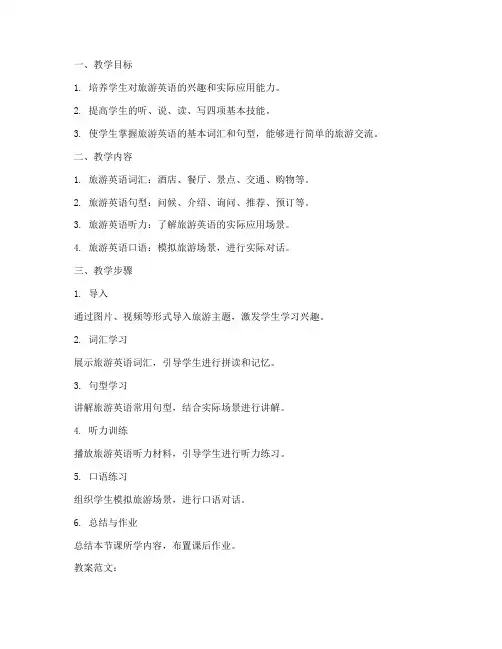
1. 培养学生对旅游英语的兴趣和实际应用能力。
2. 提高学生的听、说、读、写四项基本技能。
3. 使学生掌握旅游英语的基本词汇和句型,能够进行简单的旅游交流。
二、教学内容1. 旅游英语词汇:酒店、餐厅、景点、交通、购物等。
2. 旅游英语句型:问候、介绍、询问、推荐、预订等。
3. 旅游英语听力:了解旅游英语的实际应用场景。
4. 旅游英语口语:模拟旅游场景,进行实际对话。
三、教学步骤1. 导入通过图片、视频等形式导入旅游主题,激发学生学习兴趣。
2. 词汇学习展示旅游英语词汇,引导学生进行拼读和记忆。
3. 句型学习讲解旅游英语常用句型,结合实际场景进行讲解。
4. 听力训练播放旅游英语听力材料,引导学生进行听力练习。
5. 口语练习组织学生模拟旅游场景,进行口语对话。
6. 总结与作业总结本节课所学内容,布置课后作业。
教案范文:1. 学生能够掌握旅游英语的基本词汇和句型。
2. 学生能够在实际旅游场景中进行简单的英语交流。
3. 学生对旅游英语产生兴趣,提高学习积极性。
二、教学内容1. 旅游英语词汇:hotel、restaurant、attraction、traffic、shopping等。
2. 旅游英语句型:How are you?、Where are you from?、What’s this?、Can you help me?等。
3. 旅游英语听力:了解酒店、餐厅、景点等场景的英语对话。
4. 旅游英语口语:模拟酒店入住、餐厅点餐、景点游览等场景。
三、教学步骤1. 导入展示旅游风景图片,引导学生讨论:“What’s this place? Have you ever been there?”激发学生学习兴趣。
2. 词汇学习展示旅游英语词汇卡片,引导学生拼读和记忆。
例如:hotel、restaurant、attraction、traffic、shopping等。
3. 句型学习讲解旅游英语常用句型,如:How are you?、Where are you from?、What’s this?、Can you help me?等,结合实际场景进行讲解。
厦门兴才学院旅游酒店英语课程教学大纲第1页共4页课程名称中文:旅游酒店英语推荐教材书名:酒店英语英文:Hotel English 作者:Steve Williams课程编号1118B1 课程类型专业选修课学分/学时3学分/72学时其中实践教学时数36 实践成绩占50%开课专业商务英语专业考核方式期末考试方式闭卷笔试成绩占60%其它考核方式共 3 项成绩占 40%项目1 平时测试占20% 项目2 课堂出勤占10% 项目3 课堂表现占10%学时分配章节或项目第一、二单元第三、四单元第五、六单元第七、八单元第九、十单元第十一单元期中期末考试英语短剧表演授课学时理论 6 6 5 6 7 2 4实践 6 6 5 6 5 2 6实践教学环节(如该课有实验、上机、设计、参观等其它实践教学环节,请注明环节名称和环节学时数并另附教学大纲。
)1.学生自行参观酒店后制作PPT用英语介绍酒店。
2.让学生借助酒店服装及道具进行关于酒店的英语短剧表演。
教学手段与教学方法:请写清教师授课的方式,如使用多媒体、实物演示、需安装何教学软件等。
使用多媒体、实物等创设酒店情景,让学生进行情景模拟对话表演。
其它说明拟制签名:教研室主任审核:系主任审批:日期:日期:日期:厦门兴才学院旅游酒店英语课程教学大纲第2页共 4 页一、本课程的性质及在整个专业培养方案中的地位、作用和总体目的、要求:本课程是我校学生商务英语专业的专业选修课程,在第五个学期开设。
本课程为适应我国旅游业尤其是酒店业持续发展的需要,旨在提高学生英语交际能力,从而培养业务精通、英语熟练、全面发展的酒店初、中级管理人才。
该课程通过听、说、读、讨论、解决问题和角色扮演等教学手段培养学生从事旅游或涉外酒店专业所需的人才。
通过学习学生应达到如下要求:了解当前国际酒店业的前沿动态、发展趋势以及常用英语词汇;了解相关的酒店背景知识,在掌握酒店各部门的基本管理理论与基本服务程序的基础上具有较高英语水平。
课时:2课时年级:初中英语教材:人教版初中英语教学目标:1. 知识目标:掌握旅游英语的基本词汇和句型,如景点、交通工具、住宿、餐饮等。
2. 能力目标:提高学生运用英语进行旅游交流的能力,培养学生良好的旅游英语口语表达能力。
3. 情感目标:激发学生对旅游英语的兴趣,培养他们热爱英语、热爱生活的情感。
教学重点:1. 旅游英语基本词汇和句型的掌握。
2. 旅游场景下的英语口语交流。
教学难点:1. 旅游英语词汇的积累和应用。
2. 旅游场景下的英语口语表达。
教学准备:1. 多媒体课件:包括旅游英语词汇、句型、图片等。
2. 旅游英语对话材料。
教学过程:第一课时一、导入1. 教师展示一张旅游景点图片,引导学生用英语描述图片。
2. 学生自由交流,分享自己曾经旅游过的经历。
二、新课学习1. 教师展示旅游英语词汇和句型,如:hotel(酒店)、restaurant(餐厅)、attraction(景点)等。
2. 学生跟读、模仿,并尝试用所学词汇和句型进行简单的对话。
三、课堂练习1. 教师组织学生进行角色扮演,模拟旅游场景。
2. 学生分组进行对话练习,教师巡视指导。
四、课堂小结1. 教师总结本节课所学内容,强调重点词汇和句型。
2. 学生回顾所学,分享自己的收获。
第二课时一、复习1. 教师带领学生复习上节课所学内容,包括词汇、句型等。
2. 学生进行小组讨论,分享自己旅游的经历。
二、拓展1. 教师展示不同国家的旅游景点图片,引导学生用英语描述。
2. 学生自由交流,分享自己感兴趣的国家和景点。
三、情景模拟1. 教师组织学生进行情景模拟,模拟在旅游过程中与当地人交流的场景。
2. 学生分组进行对话练习,教师巡视指导。
四、课堂小结1. 教师总结本节课所学内容,强调重点词汇和句型。
2. 学生回顾所学,分享自己的收获。
教学反思:1. 教师要注重激发学生的学习兴趣,创设生动有趣的课堂氛围。
2. 教师要关注学生的个体差异,因材施教,提高学生的英语口语表达能力。
旅游饭店职业英语教案教案:旅游酒店职业英语教学目标:1. 学习旅游酒店行业的基本英语词汇和表达方式。
2. 掌握与旅游酒店相关的常用句型和表达。
3. 提高学生的听说读写能力,能够流利地与客人进行交流。
教学内容:1. 旅游酒店的基本概念和服务内容。
2. 旅游酒店的常用英语词汇和表达方式。
3. 与旅游酒店相关的常用句型和表达。
教学步骤:Step 1: 引入新课1. 教师向学生介绍旅游酒店的概念和服务内容,引导学生思考旅游酒店与旅游行业的关系。
2. 教师出示图片或视频,展示旅游酒店的各种设施和服务,激发学生的兴趣。
Step 2: 学习旅游酒店的基本英语词汇和表达方式1. 教师向学生介绍旅游酒店常用的英语词汇,如hotel(酒店)、room(房间)、reservation(预订)、check-in(办理入住手续)等。
2. 教师通过示范和练习,帮助学生掌握这些词汇的正确发音和用法。
Step 3: 学习与旅游酒店相关的常用句型和表达1. 教师介绍与旅游酒店相关的常用句型和表达,如:- Can I make a reservation?(我可以预订吗?)- I would like to check in.(我想办理入住手续。
) - Where is the reception desk?(前台在哪里?)- Could you please show me to my room?(请带我去我的房间。
)- Is breakfast included?(早餐包括在内吗?)2. 教师通过角色扮演和对话练习,帮助学生熟练运用这些句型和表达。
Step 4: 练习与应用1. 学生分组进行对话练习,模拟旅游酒店的场景,如预订房间、办理入住手续等。
2. 学生进行角色扮演,扮演旅游酒店的员工和客人,进行交流对话。
Step 5: 总结和复习1. 教师总结本节课的重点内容,强调学生在实际应用中的重要性。
2. 教师布置相关的课后作业,如编写旅游酒店对话场景、写一篇关于旅游酒店的英语作文等。
新疆农业职业技术学院酒店服务英语教案NO:1 课程名称酒店服务英语授课时数 2 周次班级时间年月日节次教学内容Front office DepartmentUnit 1Brief introduction of front office serviceand Room Reservation教学方式Teaching,discussion,task-based androle playContents:1.The brief introduction of front office service.1. The service procedures and service skill points about making room reservation.2. Useful hotel vocabularies and useful sentences.3. Two tasks of service practice: making the FIT and changing the room reservation. Aims:1. To master the service procedures and service skill points about making room reservation.2. To identify the useful words and apply the useful sentences.3. To have the ability to offer making room reservation, changing the room and cancelingthe room service with English.4. To get familiar with the post of front office, establish students’ service consciousness andworking responsibilities.Teaching Process Teaching strategiesLeading in (10mins)1. Greet the new students and tell the students therequirements of this course.2. “The guests are not always right, but they are alwaysguests”, how do you understand this sentence?3. Do you know what services does front office departmentoffer?Activity One:Service Procedures and Skill Points (20mins)1. Have you ever stayed in the hotel before? How did youreserve the room and what did the reservationist ask you?2.What details did the reservationist ask you about reservationinformation? e.g., name, address... .3. If you are the reservationist, how will you serve the guest,and how will you ask the guests about the detail Communicating with students.Group discussionAsk and answer questions Inspiration, ask and answer questions. Summarize the service procedures According to Ss’ experience by asking and answering questions.information? e.g., the name, telephone number... .1.Service ProceduresGreet the guest→Ask the guest about reservation information(Date of Arrival and Departure, room types, name, address, telephone number, payment, any special request)→Check the room availability→Confirm the reservation/Refuse the reservation2. Skill Points∙Pay more attention to use polite language.∙How to ask the guest about the time of his arrival anddeparture.∙How to ask the guest about his name and telephone number,and so on.Activity Two:Useful Vocabularies and Sentences (15mins)1. How many words have you known about the Front OfficeDepartment, and what are they?2. If you are a reservationist in the hotel, I’m a guest, how willyou ask these questions in English?下午好,上海希尔顿酒店前台,有什么能帮助您的吗?您是以何种方式和谁的姓名预定的?请您稍等,我来查一下这几天我们酒店是否有空房?... .1. vocabularies:Reservation, Cashier’s Counter, Information, Front OfficeManager, Reception, Front Office Supervisor and so on.2. sentences:∙Good afternoon, Hilton Shanghai, Room Reservation. May Ihelp you?∙How and in whose name has the reservation been made?∙Please wait a moment. I’ll check our rooms available forthese days. Thank you for waiting, sir. What type of roomwould you like? And so on.Activity Three:Task Setting and Practice (30mins)1. Give the Ss a few minutes to analyze and understand thetasks given by teacher, then underline the importantinformation in the tasks.2. Practice the two sample dialogues in 30mins.3. Present their dialogues before their classmates.Task One: Making the FIT→ The definition of FIT.George Brown wants to book a double room with Hilton Stressing the skill points while summarizing the service procedures. Situational method and brainstorming, most of this part can be done combined with activity one.ExplanationTask-based and role-play practice.Ss analyze the task firstly and try to underline the key information, then practice the two models ofShanghai, the room rate per night is 177 dollars,The time:from 20th to 22nd, that’s three days in all, The telephonenumber of George Brown is 0044-0246-720598, Li Conghandles the reservation.Task Two: Changing the reservationMr. Sam reserved 20 standard rooms with China WorldHotel for silk trade negotiation for April 7th,8th and 9th,Now he is calling from New York to change the date of thereservation, because the silk trade negotiation has beenpostponed until 4th to 6th of May, The hotel has just 20standard rooms available during the time, Mr. Sam books20 standard rooms and a business suite altogether from4th to 6th of May.service in pairs.Evaluation(15mins)1.Inviting two or more pairs to act their dialogue, and then the other students and I give theshort comment.2. I give the marks for the students according to their performance.Feedback (10mins)1. Summarize the main content they have learned in this class.2. Give students 10mins to ask questions they still don’t understand, I explain theirdifficulties again.Teacher’s Reference《English Practice for Hotel Service》,《Hotel Practical English》and《Front Office Management》Homework1. Recite and understand the working procedures and new words.2. Making a new dialogue according to the given task about canceling the reservation.3. Surfing on the internet to hunt the knowledge about making room reservation.课后分析:教研室主任审核签名累计学时2新疆农业职业技术学院酒店服务英语教案NO:2 课程名称酒店服务英语授课时数 2 周次班级时间年月日节次教学内容Unit 2 Extending the Stay and Changing the Room 教学方式task settingand role playContents:1. The service procedures and service skill points of extending the stay and changing theroom.2. Useful hotel vocabularies and useful sentences.3. Two tasks of service practice: extending the stay and changing the room.Aims:1. To master the service procedures and service skill points about extending the stay andchanging the room.2. To identify the useful words and apply the useful sentences.3. To have the ability to offer extending the stay and changing the room service withEnglish.4. To get familiar with the post of front office, establish students’ ser vice consciousnessand working responsibilities.Teaching Process Teaching strategiesRevision (5 mins)1.Ask one student to tell us the service procedures ofchecking in.2. Invite one student to tell the difference walk-in guest andthe guest with reservation.Leading in (5 mins)Sometimes the guest may want to change the room theyhave reserved, or they will ask for extend extra beds, if youare the receptionist, how will you deal with it?Activity One:Service Procedures and Skill Points (20mins)1. When you stayed in a hotel, did you ask for extendingextra beds or changing the room?2. If you are the receptionist, when the guest ask forextending extra beds, what questions will you ask?3. If you are the receptionist, how will you serve the guest inorders?1.Service ProceduresExtending the Stay:Greet the guest →Get the information from the guest(the Ask and answer interaction Communicating with students.Group discussionAsk and answer questions Inspiration, ask and answer questions.Summarize the service procedures According to Ss’ experience by asking and answering questions.room number, the type and number of rooms, the time of extending stay)→Search for the room available needed in the computer→ Confirm the extending stay→ Ask the guest how to make the payment→ Form the record of extending the stay→ Extend best wishesChanging the Room:Greet the guest →Ask the guest for his room number →Search for the room available needed in the computer →Form the record of changing the room→ Ask the guest to fill in the room changing form→ Extend best wishes 2. Skill Points∙When you handle the extending stay what you shouldpay attention to .∙When you handle changing the room, if the rate of thenew room is different, you should explain it to the guestclearly.Activity Two:Useful Vocabularies and Sentences (15mins)1. How many words have you known about the kinds ofroom, and what are they?2. If you are a reservationist in the hotel, I’m a guest, howwill you express these questions in Englsih? (I guide andcorrect the Ss’ mistakes)e.g, 早上好,前台。
Lesson Four: Dining OutPre-Class Preparation: make copies of Handout 6 and chop according to the roles.Objectives:1. To be able to talk about one’s most favorite food.2. To be familiar with the most frequently used food and cooking vocabulary.3. To be able to order a meal and dine with good manners in a restaurant.4. To understand the eating habits and manners of various cultures.Warm-up (5mins)Briefly talk about your favorite food and then ask students to talk about their favorite food and why they like it. Keep it short, as students will have a chance to talk about it in detail in the coming activities.Activity One: Pictures Matching Game (10mins)Refer to P31 Handout 1 of the Study Guide. Ask students to match the countries with their special food.Key:China: DumplingsAmerica : McDonalds’France: Le vin (wine)Italy: spaghettiAustralia: seafoodRussia: Borsch (Borsch is a soup, but nobody calls it soup in Russia, just “Borsch”.)Africa: Doro Wot (Range chicken legs, slow-cooked in dense stew of onions and special African plants such as berbere and kibe. Boiled small eggs are knife-poked and simmered in the stew.)Spain: PaellaJapan: SushiEskimo: seal and fishActivity Two: Cooking Verbs (5mins)Refer to Handout 2, P32 in the Study Guide. Write the following verbs on the board and ask students to work in groups identifying the methods of cooking shown in the picture.Steam boil grill/broil stir-fry deepfry bakeYou can also teach “shallow fry” as in co oking French fries, and “barbecue”.Activity Three: Tastes…? (5mins)Refer to Handout 3, P33 in the Study Guide. . Write the following adjectives on the board and ask students to work in groups identifyingthe tastes of the food in the picture.Spicy(hot), creamy(rich), plain, sweet, salty, sour, bitterActivity Four: Cooking Show Host Contest (40mins)In this activity, each student is to act as the Chef of a famous cooking show, introducing to the audience their favorite food, and howit is prepared. Each student will be given a 3-minute show time, and, at the end, a vote will be cast and one Web Cooking Show Host will be named!Before the activity, check whether your students know what acooking show is like and whether they know some of the famous cooking shows below. Give them tips on how to be a good host of a cooking show.Background Tips for TeachersA TV cooking show is a television program that presents the preparation of food, in a kitchen on the studio set. The host of the show, usually a chef, prepares a special dish over the course of the show, walking the viewing audience step by step through the preparationof the meal. Cooking shows are meant to be educational, as the host teaches the viewing audience how to prepare a different meal with each episode of the show; though some cooking shows (such as Iron Chef) are intended simply for entertainment.While rarely high-rated, cooking shows have been a popular stapleof daytime TV programming since the earliest days of television. Theyare generally very inexpensive to produce, making them a cheap and easy way for a TV station to fill a half-hour (or sometimes 60 minute) TV episode.A number of cooking shows have run for many seasons, especially when they are sponsored by local TV stations or by public broadcasting. The more popular cooking shows have had flamboyant hosts whose unique personalities have made them into celebrities.Famous cooking shows include:● Celebrity Cooks● The Cookin' Cajun● Emeril Live (Emeril Lagasse)● The French Chef (Julia Child)● The Frugal Gourmet (Jeff Smith)● Good Eats (Alton Brown)● Iron Chef● The Naked Chef (Jamie Oliver)● Two Fat Ladies● Wok with Yan● Yan Can Cook (Martin Yan)Activity Four: Order Food (10mins)In this activity, ask your students to role play ordering in a restaurant without a menu. Students’ dialogs should be simple as the following example:C: May I have the menu please?W: Of course, sir/madam. Here it is.W: Are you ready to order, sir/madam ?C: yes. I steak, please.W: Certainly. How ?C: well-done (medium/rare), please.W: Would ?C: Yes, a mixed salad would be nice.Then, talk about the courses of a formal dinner. (Appetizer, Soup, Main Course, Pizza, Spaghetti, dessert, drinks)Activity Five: Role Play (20mins)Pair Work. Each pair should take turns playing the roles of awaiter/waitress and customers at the Beach Side Café with the menu onP34 Handout 5 of the Study Guide. Preview the sentence structures in thefirst box for waiters and waitresses before role play. Ask students what they will do if they can not understand the names of dishes on a menu.。
《旅游英语》教案一、课程性质、地位和任务本科层次的学生在完成基础阶段的学习任务,达到四级或六级水平后,都必须修读专业英语,一方面为保证大学生英语学习不断线,另一方面也是使学生所掌握的英语知识能够转化成为专业技能。
旅游英语这门课属于专业选修课,是根据大学英语应用提高阶段在专业英语方面的要求而开展教学活动的,其目的是为了适应中国进一步扩大对外交流和发展出、入境旅游,培养更多的有扎实的英语专业知识又精通旅游理论的专业人才。
二、课程基本要求通过对这门课程的学习,学生们可以拓展专业知识,掌握一定的专业英语词汇,熟悉旅游英语的常用表达方法,并进一步巩固英语语言基础,提高在专业领域内综合运用英语语言的能力。
本课程要求学生在学习过程中主要锻炼英语的听、说、读能力,在工作中能够顺畅的与服务对象展开交流;要求学生在一定程度上掌握写作和翻译能力,在实践中发挥专业人才的作用。
三、教案内容Unit 1 Reservation教学目的和要求:要求学生掌握在酒店服务中如何使用英语帮助客人进行预订。
教学基本内容:Ⅰ Listening Comprehension听力对话重点句型听力Ⅱ Useful Expressions酒店服务英语的总体原则组织结构预定的常见形式预定的注意事项ⅢSituational Dialogue : Alice Liu is a secretary in Tokyo. She calls Hilton Hotel in Tianjin to reserve a suite for her boss from March 22 to 24. The reservation answers the phone call and accepts the booking.Ⅳ Reading ComprehensionText A:(1) Explain the function of the front office.(2) Use examples to describe the relationship between room reservation and other department.Ⅴ Exercises and summary本单元重点:电话预定本单元难点:服务人员在预定过程中的引领作用教学方法:讲授Unit 2 Reception教学目的和要求:要求学生能够使用英语完成登记入住服务。
《旅游英语》教案一、课程性质、地位和任务本科层次的学生在完成基础阶段的学习任务,达到四级或六级水平后,都必须修读专业英语,一方面为保证大学生英语学习不断线,另一方面也是使学生所掌握的英语知识能够转化成为专业技能。
旅游英语这门课属于专业选修课,是根据大学英语应用提高阶段在专业英语方面的要求而开展教学活动的,其目的是为了适应中国进一步扩大对外交流和发展出、入境旅游,培养更多的有扎实的英语专业知识又精通旅游理论的专业人才。
二、课程基本要求通过对这门课程的学习,学生们可以拓展专业知识,掌握一定的专业英语词汇,熟悉旅游英语的常用表达方法,并进一步巩固英语语言基础,提高在专业领域内综合运用英语语言的能力。
本课程要求学生在学习过程中主要锻炼英语的听、说、读能力,在工作中能够顺畅的与服务对象展开交流;要求学生在一定程度上掌握写作和翻译能力,在实践中发挥专业人才的作用。
三、教案内容Unit 1 Reservation教学目的和要求:要求学生掌握在酒店服务中如何使用英语帮助客人进行预订。
教学基本内容:Ⅰ Listening Comprehension听力对话重点句型听力Ⅱ Useful Expressions酒店服务英语的总体原则组织结构预定的常见形式预定的注意事项ⅢSituational Dialogue : Alice Liu is a secretary in Tokyo. She calls Hilton Hotel in Tianjin to reserve a suite for her boss from March 22 to 24. The reservation answers the phone call and accepts the booking.Text A:(1) Explain the function of the front office.(2) Use examples to describe the relationship between room reservation and other department.Ⅴ Exercises and summary本单元重点:电话预定本单元难点:服务人员在预定过程中的引领作用教学方法:讲授Unit 2 Reception教学目的和要求:要求学生能够使用英语完成登记入住服务。
教学基本内容:Ⅰ Listening Comprehension听力对话重点句型听力Ⅱ Useful Expressions入住登记的操作流程房态支付方式Ⅲ Situational Dialogue(1) A guest comes up to the Reception Desk. He has booked a double room for four nights a week ago by Ctrip. Now he wants to check-in.(2) A guest enters the hotel you served. He has no reservation. Unfortunately, all the rooms are occupied until 6:00 pm. Now it is 4 o’clock. Try to make this deal successfully.Ⅳ Reading ComprehensionText A:(1) List differences between Stars and Diamonds.(2) Describe the current situation of Star ratings in China.(3) Is it necessary to introduce Diamond ratings into China?(1) Explain the function of room categories. (From supplier perspective and guest perspective.)(2) What are the differences among POV, OV and OF. (Use Chinese to answer.) Which one will be the most expensive?Ⅴ Exercises and summary本单元重点:登记入住流程本单元难点:团队客人的登记入住教学方法:讲授Unit 3 Answer the Calls教学目的和要求:要求学生掌握酒店接听电话的方式和类别。
教学基本内容:Ⅰ Listening Comprehension听力对话重点句型听力Ⅱ Useful Expressions饭店总机的功能饭店总机的基本要求Ⅲ Situational Dialogue(1) One guest need a morning call for his 9:00 international flight. He know nothing about the traffic condition. Please give some suggestion to the guest and confirm the morning call.(2) One guest is confused by the charges of the calls. Please give some explanation. Include: house phone, local call, long distance call and international call. There is a minimum charge of first three minutes for Domestic Direct Dial but not for International Direct Dial.Ⅳ Reading ComprehensionText A: 翻译Text B:(1) Differentiate a mobile phone and a portable phone.(2) Why cell phone can be used in different countries?Ⅴ Exercises and summary本单元重点:接听电话后的正确操作方式本单元难点:叫早电话教学方法:讲授Unit 4 Complaint教学目的和要求:要求学生掌握应对客人投诉或抱怨的方法,以及处理措施。
教学基本内容:Ⅰ Listening Comprehension听力对话重点句型听力Ⅱ Useful Expressions投诉处理程序处理投诉的注意事项Ⅲ Situational Dialogue(1) Mrs. Brown complain that the hot water is not as hot as she expected. Try to deal with it.(2) Mr. Green is very unhappy with the restaurant service in the hotel. The manager is handling the complaint.Ⅳ Reading ComprehensionText A:(1) If you are an employee, what is your attitude toward the customer complaints?(2) If you are the manager, what is your attitude toward the customer complaints?(3) If you are the owner of the hotel, what is your attitude toward the customer complaints?(4) How to manage customer complaints?Text B:(1) Classify all the complaints in Poor Service. Try to resolves these problems.(2) Should we inform guests some problems about the room when they make a reservation.Ⅴ Exercises and summary应对客人投诉的方法本单元难点:如何舒缓客人情绪教学方法:讲授Unit 5 Check-out教学目的和要求:要求学生能够使用英语完成对客人离店退宿的服务。
教学基本内容:Ⅰ Listening Comprehension听力对话重点句型听力Ⅱ Useful Expressions结账退宿的操作流程账单上常见的缩写Ⅲ Situational Dialogue(1) Mrs. Smith is in Room 2210 and she is checking out. Her bill is ¥1250. She wants to settle the bill with cash. You find that the cash is not RMB or USD but HKD. As the hotel regulation, HKD is not accepting. Try to help her to check out.(2) Miss Chen has stayed in the hotel for 4 days and she is going to check out. She finds that if she reserved by Ctrip she could get 15% discount. Now she requires the discount. But you find that she made the reservation by telephone. Try to deal with this problem.Ⅳ Reading ComprehensionText A:(1) What is account?(2) What is folio?(3) Differentiate account from folio.Ⅴ Exercises and summary本单元重点:离店退宿的流程本单元难点:教学方法:讲授Unit 6 Housekeeping教学目的和要求:要求学生了解客房部的常见服务及应对措施。